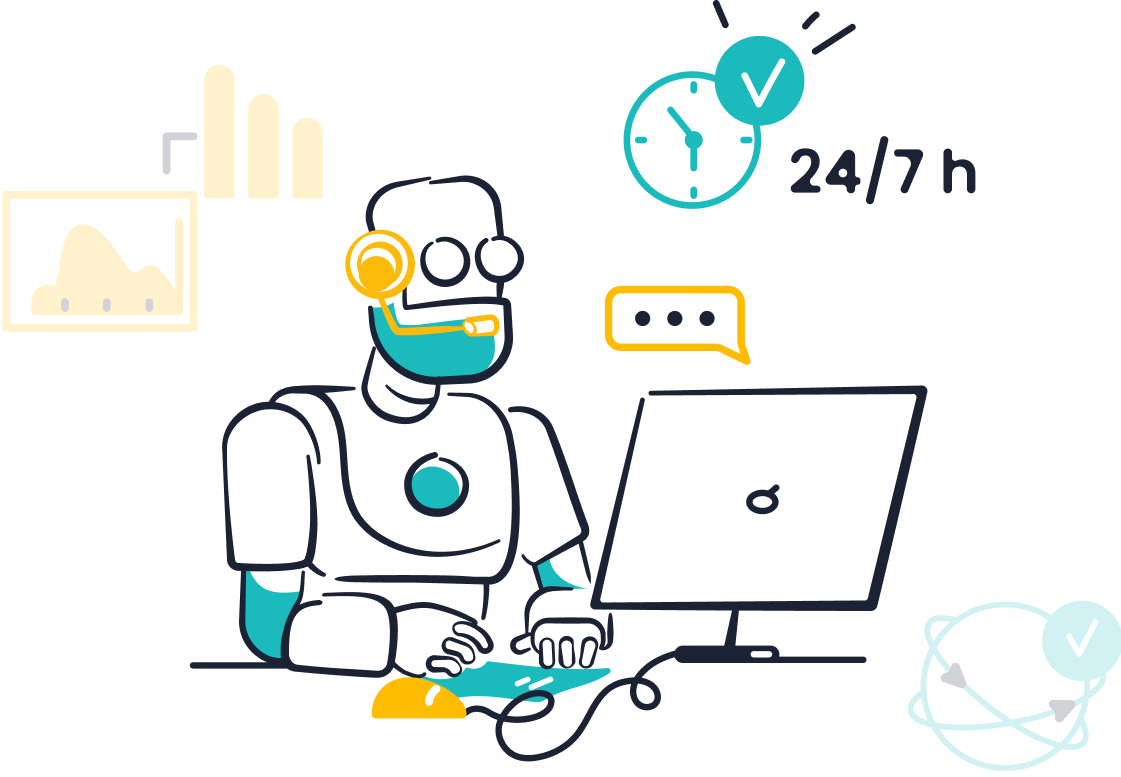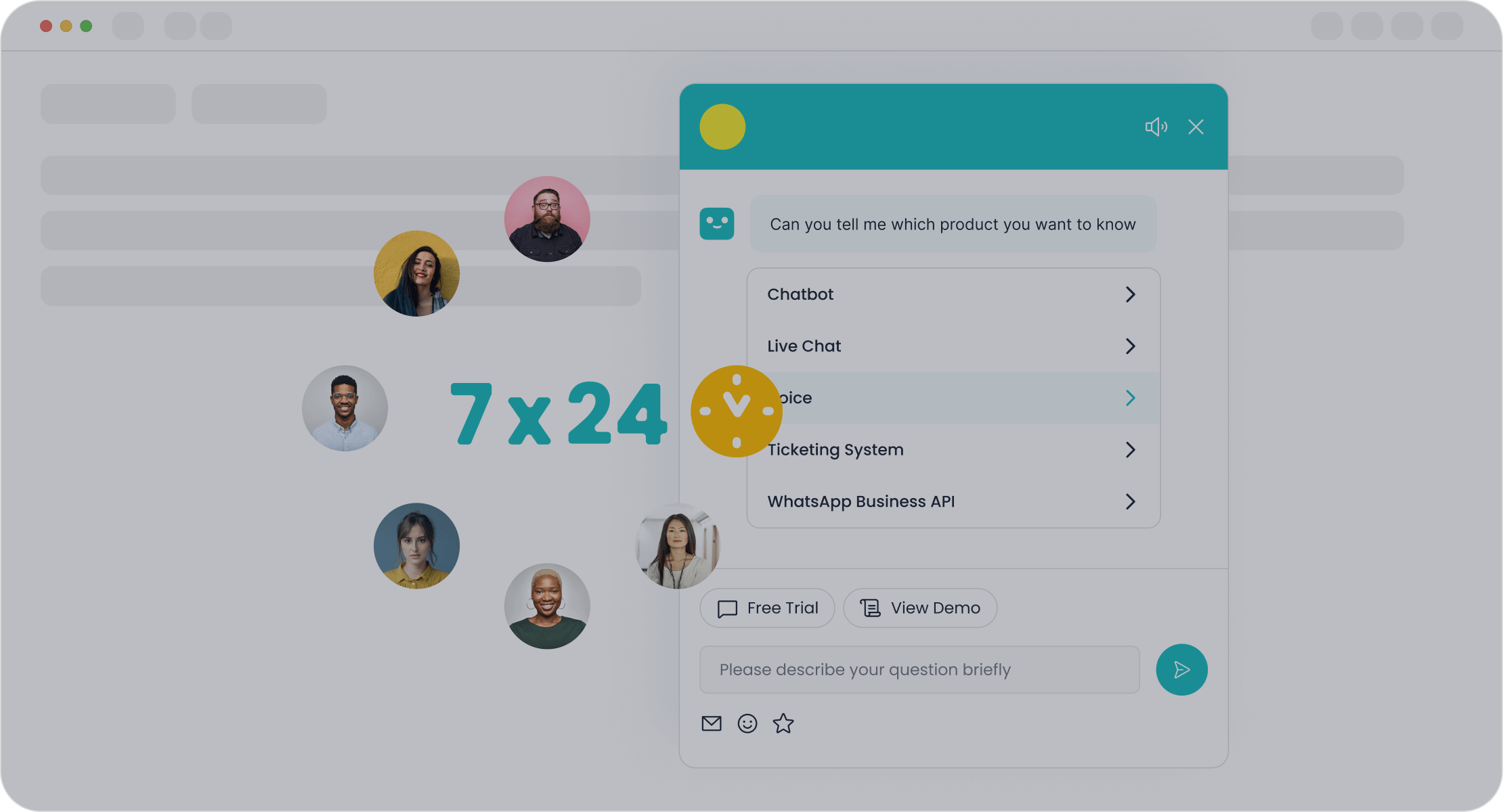How to Use Chatbot Automation for Better Engagement

Chatbot automation transforms how you engage with customers by delivering instant, personalized interactions. It ensures faster responses, which 69% of consumers prefer for resolving queries. Sobot's Chatbot takes this a step further with its AI-powered, multilingual capabilities, offering 24/7 support and boosting customer engagement by up to 20%. Modern businesses adopting chatbots gain a competitive edge, as 62% of users favor bots over waiting for human agents. By integrating chatbot automation, you can enhance satisfaction, streamline operations, and build stronger connections with your audience.
Understanding Chatbot Automation
What Is Chatbot Automation?
Definition and key features

Chatbot automation refers to the use of intelligent bots to handle customer interactions without human intervention. These bots streamline communication by providing instant responses, solving common queries, and guiding users through processes. Key features include 24/7 availability, multilingual support, and integration across multiple platforms. For example, Sobot's chatbot offers omnichannel support, allowing you to interact with customers on WhatsApp, SMS, and other preferred channels. This ensures seamless communication and enhances customer satisfaction.
Businesses across industries are adopting chatbot automation at a rapid pace. A recent study shows that 58% of B2B companies now use chatbots on their websites, while 90% of businesses report faster complaint resolution due to automation. These statistics highlight the growing importance of chatbots in improving customer service.
Role of AI and NLP in chatbot functionality
Artificial Intelligence (AI) and Natural Language Processing (NLP) power chatbot automation, enabling bots to understand and respond to customer queries effectively. AI allows chatbots to learn from interactions, improving their accuracy over time. NLP helps bots interpret human language, including slang and regional phrases, making conversations more natural.

For instance, Sobot's chatbot uses AI to analyze customer intent and provide real-time assistance. Its NLP capabilities ensure accurate responses, even in complex scenarios. This combination of AI and NLP creates a personalized experience, building trust and loyalty with your audience.
How Chatbot Automation Works
Integration with customer service platforms
Chatbot automation integrates seamlessly with customer service platforms to enhance efficiency. By connecting with tools like ticketing systems and live chat, chatbots can handle repetitive tasks, such as answering FAQs or triaging inquiries. This frees up human agents to focus on complex issues.
For example, Delta Airlines uses chatbots to provide flight updates and check-in assistance, while Bank of America offers financial advice through its chatbot. These integrations improve service quality and reduce response times, ensuring a better experience for customers.
Data-driven personalization and real-time responses
Chatbot automation leverages customer data to deliver personalized interactions. By analyzing past behavior and preferences, chatbots can offer tailored recommendations and solutions. Real-time responses further enhance the experience, as customers receive instant support without waiting.

Sobot's chatbot excels in this area by using data to predict customer needs and proactively engage with them. This approach not only improves satisfaction but also boosts conversion rates by 20%. With such capabilities, chatbot automation becomes a powerful tool for modern businesses.

Benefits of Chatbot Automation for Improved Customer Engagement

Faster and More Efficient Responses
24/7 availability and instant replies
Chatbot automation ensures your customers receive support whenever they need it. With 24/7 availability, chatbots provide instant replies, eliminating the frustration of waiting for assistance. Studies show that chatbots can reduce first response times from 15-60 minutes to under 5 seconds. This speed enhances customer satisfaction and keeps your audience engaged.
For example, Sobot's chatbot operates round-the-clock, handling inquiries across multiple platforms like WhatsApp and SMS. This omnichannel support ensures seamless communication, no matter where your customers reach out. By offering instant responses, you can build trust and improve the overall customer experience.
Reducing wait times and improving satisfaction
Long wait times often lead to dissatisfaction. Chatbot automation addresses this by resolving queries quickly. Resolution times can drop from 24-48 hours to just 5-10 minutes. This efficiency not only improves customer satisfaction but also boosts engagement.
Dialzara, a retail brand, optimized its chatbot and saw a noticeable drop in support queries. This demonstrates how automation can streamline customer service and enhance satisfaction. Faster responses create a positive impression, encouraging customers to return.
Personalized Customer Interactions
Tailored recommendations using customer data
Chatbots use customer data to deliver personalized experiences. By analyzing past interactions, they can offer tailored recommendations that meet individual needs. Studies reveal that personalized interactions can increase customer engagement by up to 20%.
H&M's chatbot exemplifies this by providing product recommendations and sizing assistance. Similarly, Sobot's chatbot predicts customer needs and offers real-time solutions. These personalized experiences make your customers feel valued, strengthening their loyalty.
Proactive engagement through automated follow-ups
Automation enables chatbots to engage proactively. They can send follow-up messages, remind customers about abandoned carts, or share updates on orders. This proactive approach keeps your audience engaged and encourages action.
Capital One's Eno chatbot uses this strategy effectively. It sends fraud alerts and account updates, ensuring customers stay informed. Proactive engagement builds trust and enhances the overall customer experience.
Cost Savings and Scalability
Handling high volumes of inquiries efficiently
Chatbot automation allows you to manage large volumes of inquiries without compromising quality. By automating repetitive tasks, chatbots free up human agents to focus on complex issues. This scalability ensures consistent service during peak periods.

For instance, digital assistants in banking save between $0.50 and $0.70 per interaction. This translates to billions in global savings. Sobot's chatbot handles high volumes efficiently, reducing operational costs while maintaining excellent service.
Reducing the need for additional customer service agents
Hiring more agents to handle increased demand can be costly. Chatbots reduce this need by managing routine queries autonomously. They operate 24/7, saving up to 50% on additional agent costs.
Sobot's chatbot improves productivity by 70%, allowing your team to focus on strategic tasks. This cost-effective solution ensures you deliver exceptional service without stretching your budget.
Enhanced Customer Experience
Consistent and accurate responses
Consistency in responses plays a vital role in delivering a positive customer experience. Chatbot automation ensures that every interaction provides accurate and reliable information. Unlike human agents, chatbots do not suffer from fatigue or errors caused by repetitive tasks. This guarantees consistency across all customer interactions.

For example, Sobot's chatbot uses a centralized knowledge base to provide precise answers to common queries. It pulls information from articles, PDFs, and other sources, ensuring accuracy. Whether a customer asks about product features or order status, the chatbot delivers the same high-quality response every time. This level of consistency builds confidence in your service.
Studies show that 75% of customers value consistent experiences across channels. Chatbot automation meets this expectation by maintaining uniformity in responses, regardless of the platform. This reliability enhances customer satisfaction and strengthens engagement.
Building trust and loyalty through seamless interactions
Trust grows when customers feel valued and understood. Chatbot automation fosters this by offering seamless interactions tailored to individual needs. With 24/7 availability, chatbots ensure customers receive support whenever they need it. This accessibility demonstrates your commitment to their satisfaction.
Sobot's chatbot excels in proactive engagement. It uses customer data to predict needs and offer personalized solutions. For instance, it can remind customers about abandoned carts or provide updates on orders. These thoughtful interactions create a sense of care and attention.
A report by PwC highlights that 73% of customers consider experience a key factor in their purchasing decisions. By using chatbot automation to deliver smooth and personalized interactions, you can build loyalty and encourage repeat business. Over time, these efforts translate into stronger relationships and higher engagement.
Real-World Applications of Chatbot Automation

E-commerce and Retail
Assisting with product recommendations and purchases
Chatbots have revolutionized e-commerce by simplifying the shopping experience. They analyze customer preferences and browsing history to suggest products tailored to individual needs. For instance, H&M's AI-powered chatbot assists customers with product recommendations and sizing, ensuring a seamless shopping journey. Similarly, Amazon's Alexa enables voice-based shopping, making purchases more convenient.
This automation improves engagement and drives sales. A study shows that personalized product recommendations can increase repeat purchases by 36%. By integrating chatbots into your e-commerce platform, you can enhance customer satisfaction and boost conversions.
Managing order tracking and returns
Order tracking and returns often overwhelm customer service teams. Chatbots streamline these processes by providing real-time updates and guiding customers through return policies. For example, Sobot's chatbot offers omnichannel support, allowing customers to track orders on platforms like WhatsApp or SMS. This reduces response times and improves the overall service experience.
Metrics confirm the impact of automation in e-commerce. Resolution times drop by 52%, while customer satisfaction scores see a 1% increase. These improvements highlight how chatbots enhance efficiency and build trust with your audience.

Financial Services
Answering account-related queries
In the financial sector, chatbots handle routine queries like balance checks and transaction details. Capital One's Eno chatbot exemplifies this by offering instant account information. This automation reduces wait times and ensures customers receive accurate responses.

Sobot's chatbot also excels in this area. It integrates with banking systems to provide real-time assistance, enhancing the customer service experience. By automating these tasks, banks can focus on more complex customer needs while maintaining high service standards.
Fraud detection and proactive alerts
Fraud prevention is critical in financial services. AI-powered chatbots monitor transactions for unusual activity and send real-time alerts to customers. This proactive approach enhances security and builds trust. For example, machine learning enables chatbots to detect fraudulent patterns swiftly, minimizing risks.
Banks using chatbots report significant improvements in fraud prevention. Customers benefit from immediate alerts, ensuring their accounts remain secure. This automation not only protects assets but also strengthens customer loyalty.
| Key Point | Description |
|---|---|
| Fraud Detection | AI chatbots monitor transactions for signs of fraudulent activity. |
| Real-Time Alerts | Chatbots provide immediate alerts about unusual activities. |
| Machine Learning | Utilizes machine learning for swift detection and prevention of fraud. |
Travel and Hospitality
Booking assistance and itinerary updates
Chatbots simplify travel planning by assisting with bookings and itinerary updates. For example, Kris, Singapore Airlines' chatbot, allows customers to modify bookings quickly without human intervention. This automation reduces call center workloads and improves response times.
Sobot's chatbot offers similar capabilities, operating 24/7 to provide real-time assistance. Whether customers need to book a flight or update their itinerary, chatbots ensure a smooth experience. This accessibility enhances customer satisfaction and loyalty.
Addressing traveler concerns in real-time
Travelers often face unexpected issues, such as flight delays or lost baggage. Chatbots address these concerns instantly, offering solutions without long wait times. Delta Airlines' chatbot provides updates on flights and baggage, ensuring customers stay informed.
AI-driven chatbots also reduce staff workloads by handling repetitive inquiries. Clara, a travel chatbot, managed over 1 million conversations, demonstrating the scalability of automation. By adopting chatbots, you can deliver exceptional service and improve the travel experience.
- AI chatbots operate 24/7, ensuring faster responses.
- Real-time assistance reduces call center workloads.
- Automation enhances customer satisfaction and loyalty.
Sobot Success Story: OPPO
Achieving an 83% chatbot resolution rate
OPPO, a global leader in smart devices, faced challenges in managing high volumes of customer inquiries during peak shopping seasons. You can imagine how overwhelming it gets when thousands of customers need assistance simultaneously. To address this, OPPO implemented Sobot's chatbot solution. This chatbot efficiently handled repetitive queries, allowing human agents to focus on complex issues.
The results were remarkable. OPPO achieved an 83% resolution rate for customer inquiries through the chatbot alone. This means that out of every 100 inquiries, 83 were resolved without human intervention. The chatbot's ability to provide instant and accurate responses played a key role in this success. It operated 24/7, ensuring customers received support whenever they needed it. By automating routine tasks, OPPO not only improved efficiency but also enhanced customer satisfaction.
Increasing repurchase rates through proactive engagement
Proactive engagement is essential for building strong relationships with your customers. OPPO leveraged Sobot's chatbot to take this to the next level. The chatbot used customer data to predict needs and send personalized follow-ups. For example, it reminded customers about abandoned carts and shared updates on new product launches.
This proactive approach led to a 57% increase in OPPO's repurchase rate. Customers appreciated the timely and relevant interactions, which made them feel valued. The chatbot's ability to engage across multiple channels, including WhatsApp and SMS, ensured seamless communication. By adopting this strategy, OPPO not only boosted sales but also strengthened customer loyalty.
Tip: Proactive engagement through chatbots can transform your customer relationships. Use data-driven insights to personalize interactions and keep your audience engaged.
Best Practices for Implementing Chatbot Automation
Setting Clear Objectives
Identifying customer service challenges
Before implementing chatbot automation, you need to identify the specific challenges your customer service team faces. Common issues include long response times, high inquiry volumes, or inconsistent service quality. For example, Delta Airlines used a chatbot to address delays in providing flight updates and baggage information. By pinpointing these challenges, they improved operational efficiency and reduced waiting times. Understanding your pain points helps you design a chatbot that aligns with your business needs.
Defining measurable goals for engagement improvement
Setting measurable goals ensures your chatbot delivers results. Define clear objectives, such as reducing response times by 50% or increasing customer engagement by 20%. Use Key Performance Indicators (KPIs) like resolution rates, customer satisfaction scores, and engagement metrics to track progress. For instance, Sobot's chatbot helps businesses achieve up to 83% resolution rates, proving the importance of goal-setting in automation success.
Choosing the Right Chatbot Solution
Evaluating platforms like Sobot's Chatbot
Selecting the right chatbot platform is crucial. Look for features like 24/7 availability, multilingual support, and seamless integration with your existing systems. Sobot's chatbot offers these capabilities, making it an excellent choice for businesses aiming to enhance customer service. Additionally, ensure the platform supports omnichannel communication, allowing you to engage customers on their preferred platforms like WhatsApp or SMS.
Ensuring compatibility with existing systems
Your chatbot should integrate smoothly with your current tools, such as ticketing systems or live chat platforms. This compatibility ensures a unified customer service experience. For example, Sobot's chatbot connects with various systems to streamline operations and improve service quality. A well-integrated chatbot reduces manual effort and enhances efficiency, making it easier to manage customer interactions.
Prioritizing Personalization
Leveraging customer data responsibly
Personalization is key to successful chatbot automation. Use customer data to tailor interactions, but handle this data responsibly to maintain trust. For instance, chatbots can analyze purchase history to recommend products or send reminders about abandoned carts. Sobot's chatbot excels in personalization by predicting customer needs and offering real-time solutions, boosting engagement and satisfaction.
Continuously refining chatbot responses
Regularly updating your chatbot ensures it stays relevant and effective. Monitor performance metrics like response accuracy and customer feedback to identify areas for improvement. Use this data to refine your chatbot's responses and enhance its capabilities. A well-maintained chatbot not only improves service quality but also strengthens customer loyalty over time.
Monitoring and Optimizing Performance
Tracking key metrics like response time and satisfaction
To ensure your chatbot automation performs effectively, you need to monitor key metrics regularly. Metrics like response time, resolution rate, and customer satisfaction scores (CSAT) provide valuable insights into your chatbot's efficiency. For example, a chatbot with a response time under 5 seconds can significantly improve customer satisfaction. Studies show that 90% of customers expect immediate responses when contacting businesses. Tracking these metrics helps you identify areas where your chatbot excels and where it needs improvement.
Sobot's chatbot includes built-in analytics tools that make tracking these metrics simple. You can access detailed reports on response times, customer feedback, and engagement rates. These insights allow you to measure the impact of your chatbot automation on customer service. For instance, if your CSAT score drops, you can investigate whether the chatbot's responses align with customer expectations. By keeping a close eye on these metrics, you can ensure your chatbot consistently delivers high-quality service.
Tip: Use tools like Sobot's reporting dashboard to visualize trends and make data-driven decisions.
Regularly updating chatbot workflows
Chatbot workflows require regular updates to stay relevant and effective. Customer needs evolve, and your chatbot must adapt to meet these changes. For instance, if you launch a new product, updating the chatbot's knowledge base ensures it can answer related questions accurately. Neglecting updates can lead to outdated responses, which may frustrate customers.
Sobot's chatbot simplifies this process with its no-coding-required interface. You can easily modify workflows, add new FAQs, or refine existing ones. Regular updates also help your chatbot learn from past interactions. By analyzing customer queries, you can identify patterns and adjust workflows to improve accuracy. For example, if customers frequently ask about shipping policies, you can create a dedicated workflow to address this topic.
Note: Schedule periodic reviews of your chatbot's performance to ensure it aligns with your business goals and customer expectations.
By tracking metrics and updating workflows, you can maximize the potential of chatbot automation. These practices not only enhance customer satisfaction but also ensure your chatbot remains a valuable asset for your business.
The Future of Chatbot Automation in Customer Engagement
Emerging Trends in Chatbot Technology
AI advancements for more human-like interactions
Artificial Intelligence continues to evolve, making chatbots more intuitive and human-like. Modern AI systems, such as ChatGPT, enhance interactions by understanding context and responding naturally. This shift moves away from rigid, scripted replies to personalized and conversational support. For example, chatbots can now detect emotions in text, allowing them to adjust their tone and provide empathetic responses. These advancements redefine customer service, creating experiences that feel less robotic and more engaging.
Sobot's chatbot leverages AI to deliver these human-like interactions. It uses advanced algorithms to analyze customer intent and provide accurate, context-aware replies. This capability ensures your customers feel understood and valued, strengthening their trust in your brand.
Integration with voice assistants and IoT devices
Chatbots are no longer limited to text-based platforms. They now integrate seamlessly with voice assistants like Alexa and Google Assistant, as well as IoT devices. This integration allows customers to interact with chatbots through smart speakers, wearables, or even connected appliances. For instance, a chatbot integrated with a smart refrigerator can notify users about expiring groceries or suggest recipes based on available ingredients.
Sobot's chatbot supports omnichannel communication, making it adaptable to these emerging technologies. By embracing such integrations, you can offer your customers a more convenient and connected experience.
Long-Term Benefits for Businesses
Strengthening customer relationships
Chatbot automation plays a crucial role in building lasting customer relationships. By providing instant, personalized support, chatbots make customers feel valued. Proactive engagement, such as sending reminders or updates, further strengthens this bond. Studies show that businesses using chatbots see a 20% increase in customer retention rates.
Sobot's chatbot excels in this area by using data-driven insights to predict customer needs. Its ability to engage across multiple channels ensures consistent and meaningful interactions, fostering loyalty and trust.
Staying competitive in a digital-first world
The chatbot market is growing rapidly, with projections estimating a market size of $15.5 billion by 2028, up from $4.7 billion in 2022. This growth highlights the increasing importance of automation in staying competitive. Businesses adopting chatbot automation gain a significant edge by offering faster, more efficient service.
| Year Range | Market Size (in billion USD) | Annual Growth Rate (%) |
|---|---|---|
| 2022 | 4.7 | N/A |
| 2023-2028 | 15.5 | 23.3 |
Sobot's chatbot helps businesses adapt to this digital-first landscape. Its 24/7 availability and multilingual support ensure you meet customer expectations, keeping you ahead in a competitive market.
Chatbot automation transforms customer engagement by offering instant, personalized, and efficient interactions. It ensures faster responses, with 69% of users preferring chatbots for quick answers. Businesses also report a 57% ROI from chatbot usage, showcasing its value in modern customer service.
| Statistic | Percentage |
|---|---|
| Prefer interacting with a chatbot over waiting for an agent | 62% |
| Would use chatbots for instant responses to queries | 69% |
| Choose a chatbot for answers to simple questions | 74% |
| Businesses report significant ROI from chatbot usage | 57% |
Sobot's Chatbot stands out as a leader in this space. It achieves a 97% Customer Satisfaction Score (CSAT) and resolves 85% of problems autonomously. Its ability to reduce inbound discussion volume by 20% while maintaining a 99% customer happiness rate makes it an essential tool for businesses.

By adopting Sobot's Chatbot, you can enhance customer satisfaction, reduce costs, and scale operations effortlessly. Explore chatbot automation today to revolutionize your customer service and stay ahead in a digital-first world.
FAQ
1. How does chatbot automation improve customer engagement?
Chatbot automation enhances engagement by providing instant, personalized responses. For example, Sobot's chatbot operates 24/7, ensuring customers receive support anytime. Studies show that 69% of users prefer chatbots for quick answers, which helps businesses build trust and improve satisfaction. Learn more about Sobot's chatbot here.
2. Can chatbots handle complex customer queries?
Yes, chatbots can manage complex queries by integrating with knowledge bases and AI systems. Sobot's chatbot uses AI to analyze customer intent and provide accurate solutions. For example, it resolves 83% of inquiries autonomously, freeing agents to focus on more intricate issues. This ensures efficient and effective service.
3. Is chatbot automation suitable for small businesses?
Absolutely! Chatbot automation benefits businesses of all sizes. Sobot's chatbot offers a no-coding-required setup, making it easy for small businesses to deploy. It reduces costs by up to 50% and boosts productivity by 70%, helping smaller teams manage customer interactions efficiently.
4. How do chatbots ensure data security?
Chatbots prioritize data security by using encryption and compliance protocols. Sobot's chatbot adheres to strict security standards, ensuring customer information remains safe. For example, it integrates securely with platforms like WhatsApp, protecting sensitive data during interactions.
5. What industries benefit most from chatbot automation?
Industries like retail, finance, and travel gain the most from chatbot automation. For instance, Sobot's chatbot helps e-commerce brands with product recommendations and order tracking. In finance, it provides account updates and fraud alerts. Its versatility makes it valuable across various sectors.
Tip: Explore how Sobot's chatbot can transform your industry by visiting Sobot's website.
See Also
Steps to Build a Successful Chatbot for Your Site
Simple Ways to Integrate Chatbots on Your Website
Enhancing Customer Satisfaction with E-commerce Chatbots